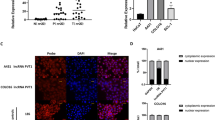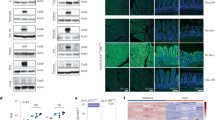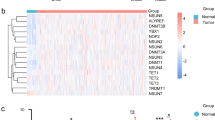ABSTRACT
C/EBPβ (CCAAT/enhancer-binding protein β) is an important transcription factor involved in cellular proliferation and differentiation. Overexpression of the full-length C/EBPβ protein results in cellular growth arrest and apoptosis. Using a nonviral liposome as carrier, we delivered the full-length C/EBPβ expression plasmid, pCN, into nude mice bearing CW-2 human colon cancer tumors via tail vein. Southern blots revealed that the major organs and tumors were transfected. Experimental gene therapy showed that a strong suppression of tumor growth was observed in the pCN-treated mice, and such suppression was due to the overexpression of C/EBPβ, leading to the increased apoptosis in tumors of pCN-treated mice. No apparent toxic effects of pCN/liposome complex were observed in the animals. Thus, C/EBPβ has tumor suppression effect in vivo and may be used in gene therapy for cancers.
Similar content being viewed by others
Log in or create a free account to read this content
Gain free access to this article, as well as selected content from this journal and more on nature.com
or
References
Vainio H, Miller AB . Primary and secondary prevention in colorectal cancer. Acta Oncol 2003; 42:809–15.
Akira S, Isshiki H, Sugita T, et al. A nuclear factor for IL-6 expression (NF-IL6) is a member of a C/EBP family. EMBO J. 1990; 9:1897–906.
Ramji DP, Foka P . CCAAT/enhancer-binding proteins: structure, function and regulation. Biochem J. 2002; 365:561–75.
Williams SC, Cantwell CA, Johnson PF . A family of C/EBP-related proteins capable of forming covalently linked leucine zipper dimers in vitro. Genes Dev 1991; 5:1553–67.
Lekstrom-Himes J, Xanthopoulos KG . Biological role of the CCAAT/enhancer-binding protein family of transcription factors. J Biol Chem 1998; 273:28545–8.
Grimm SL, Rosen JM . The role of C/EBPbeta in mammary gland development and breast cancer. J Mammary Gland Biol Neoplasia. 2003; 8:191–204.
Umek RM, Friedman AD, McKnight SL . CCAAT-enhancer binding protein: a component of a differentiation switch. Science 1991; 251:288–92.
Blais S, Boudreau F, Beaulieu JF, Asselin C . CCAAT/enhancer binding protein isoforms expression in the colon of neonatal mice. Dev Dyn 1995; 204:66–76.
Chandrasekaran C, Gordon JI . Cell lineage-specific and differentiation-dependent patterns of CCAAT/enhancer binding protein α expression in the gut epithelium of normal and transgenic mice. Proc Natl Acad Sci U S A 1993; 90:8871–5.
Chinery R, Brockman JA, Peeler MO, Shyr Y, Beauchamp RD, Coffey RJ . Antioxidants enhance the cytotoxicity of chemotherapeutic agents in colon cancer: a p53-independent induction of p21WAF1/CIP1 via C/EBPbeta. Nat Med 1997; 3:1233–41.
Qiao D, Im E, Qi W, Martinez JD . Activator protein-1 and CCAAT/enhancer-binding protein mediated GADD153 expression is involved in deoxycholic acid-induced apoptosis. Biochim Biophys Acta 2002; 1583:108–16.
Tanaka T, Akira S, Yoshida K, et al. Targeted disruption of the NF-IL6 gene discloses its essential role in bacteria killing and tumor cytotoxicity by macrophages. Cell 1995; 80:353–61.
Liu HD, Liu DG . Enhancement of Macrophage Cytotoxicity by Overexpression of Exogenous NF-IL6 Gene. Sheng Wu Hua Xue Yu Sheng Wu Wu Li Xue Bao 2001; 33:35–40.
Zhu S, Yoon K, Sterneck E, Johnson PF, Smart RC . CCAAT/enhancer binding protein-beta is a mediator of keratinocyte survival and skin tumorigenesis involving oncogenic Ras signaling. Proc Natl Acad Sci U S A 2002; 99:207–12.
Zhu MS, Liu DG, Li ZP . Tumorigenic properties of NIH3T3 cells that overexpress NF-IL6 that was cotransfected with pMSEx-1 plasmid. J Cell Mol Immunol. (Beijing) 1998; 14:93–95 (in Chinese with English abstract).
Zhu MS, Liu DG, Cheng HQ, Xu XY, Li ZP . Expression of exogenous NF-IL6 induces apoptosis in Sp2/0-Ag14 myeloma cells. DNA Cell Biol 1997; 16:127–35.
Mukherjee D, Kaestner KH, Kovalovich KK, Greenbaum LE . Fas-induced apoptosis in mouse hepatocytes is dependent on C/EBPbeta. Hepatology 2001; 33:1166–72.
Templeton NS, Lasic DD, Frederik PM, et al. Improved DNA: liposome complexes for increased systemic delivery and gene expression. Nat Biotechnol 1997; 15:647–52.
Ramesh R, Saeki T, Templeton NS, et al. Successful treatment of primary and disseminated human lung cancers by systemic delivery of tumor suppressor genes using an improved liposome vector. Mol Ther 2001; 3:337–50.
Fang FD, Zhou L, Ding L, Zhang DC, eds. A collection of experimental techniques in modern medicine. Joint Press of Beijing Medical University and China Concord Medical University: Beijing 1995; 1:14–104. (in Chinese).
Siders, WM, Vergillis K, Johnson C, Scheule RK, Kaplan JM . Tumor treatment with complexes of cationic lipid and noncoding plasmid DNA results in the induction of cytotoxic T cells and systemic tumor elimination. Mol Ther 2002; 6:519–27.
Hofland H, Huang L . Inhibition of human ovarian carcinoma cell proliferation by liposome-plasmid DNA complex. Biochem Biophys Res Commun 1995; 207:492–6.
Dow SW, Fradkin LG, Liggitt DH, et al. Lipid-DNA complexes induce potent activation of innate immune responses and antitumor activity when administered intravenously. J Immunol 1999; 163:1552–61.
Culp SJ . NTP technical report on the toxicity studies of malachite green chloride and leucomalachite green (CAS Nos. 569-64-2 and 129-73-7) administered in feed to F344/N rats and B6C3F1 mice. Toxic Rep Ser 2004; 71:1–F10.
Qureshi S, al-Harbi MM, Ahmed MM, et al. Evaluation of the genotoxic, cytotoxic, and antitumor properties of Commiphora molmol using normal and Ehrlich ascites carcinoma cell-bearing Swiss albino mice. Cancer Chemother Pharmacol 1993; 33:130–8.
Hanna N, Davis TW, Fidler IJ . Environmental and genetic factors determine the level of NK activity of nude mice and affect their suitability as models for experimental metastasis. Int J Cancer 1982; 30:371–6.
Gheorghiu I, Deschenes C, Blais M, et al. Role of specific CCAAT/enhancer-binding protein isoforms in intestinal epithelial cells. J Biol Chem. 2001; 276:44331–7.
Buck M, Turler H, Chojkier M . LAP (NF-IL-6), a tissue-specific transcriptional activator, is an inhibitor of hepatoma cell proliferation. EMBO J. 1994; 13:851–60.
Eaton EM, Hanlon M, Bundy L, Sealy L . Characterization of C/EBPbeta isoforms in normal versus neoplastic mammary epithelial cells. J Cell Physiol. 2001; 189:91–105.
Descombes P, Schibler U . A liver-enriched transcriptional activator protein, LAP, and a transcriptional inhibitory protein, LIP, are translated from the same mRNA. Cell 1991; 67:569–79.
Dearth LR, Hutt J, Sattler A, Gigliotti A, DeWille J . Expression and function of CCAAT/enhancer binding proteinbeta (C/EBPbeta) LAP and LIP isoforms in mouse mammary gland, tumors and cultured mammary epithelial cells. J Cell Biochem 2001; 82:357–70.
Zahnow CA, Younes P, Laucirica R, Rosen JM . Overexpression of C/EBPbeta-LIP, a naturally occurring, dominant-negative transcription factor, in human breast cancer. J Natl Cancer Inst 1997; 89:1887–91.
Zahnow CA, Cardiff RD, Laucirica R, Medina D, Rosen JM . A role for CCAAT/enhancer binding protein beta-liver-enriched inhibitory protein in mammary epithelial cell proliferation. Cancer Res 2001; 61:261–9.
Lane MD, Tang QQ, Jiang MS . Role of the CCAAT enhancer binding proteins (C/EBPs) in adipocyte differentiation. Biochem Biophys Res Commun 1999; 266:677–83.
Zhu S, Oh HS, Shim M, et al. C/EBPbeta modulates the early events of keratinocyte differentiation involving growth arrest and keratin 1 and keratin 10 expression. Mol Cell Biol 1999; 19:7181–90.
Acknowledgements
This work was supported by grants from the National Natural Science Foundation of China (No.39970172), a grant from the CAS-Pudong Hightech Seed Foundation, a grant from Shanghai-SK R& D Foundation, and a grant from the Creation Foundation, Shanghai Institutes for Biological Sciences.
The authors thank Shizuo AKIRA (Kyoto University, Japan) for the C/EBPβ (NF-IL6) full-length cDNA; Feng LIU and Jin Mei ZHANG for routine breeding of nude mice; Hai Juan DU, Da WANG, Xin Yuan LIU, Yun Yi WEI, Ying Ling HUANG and Xiao Jiang WU for help in work.
Author information
Authors and Affiliations
Corresponding author
Rights and permissions
About this article
Cite this article
SUN, L., FU, B. & LIU, D. Systemic delivery of full-length C/EBPβ/liposome complex suppresses growth of human colon cancer in nude mice. Cell Res 15, 770–776 (2005). https://doi.org/10.1038/sj.cr.7290346
Received:
Revised:
Accepted:
Issue date:
DOI: https://doi.org/10.1038/sj.cr.7290346



